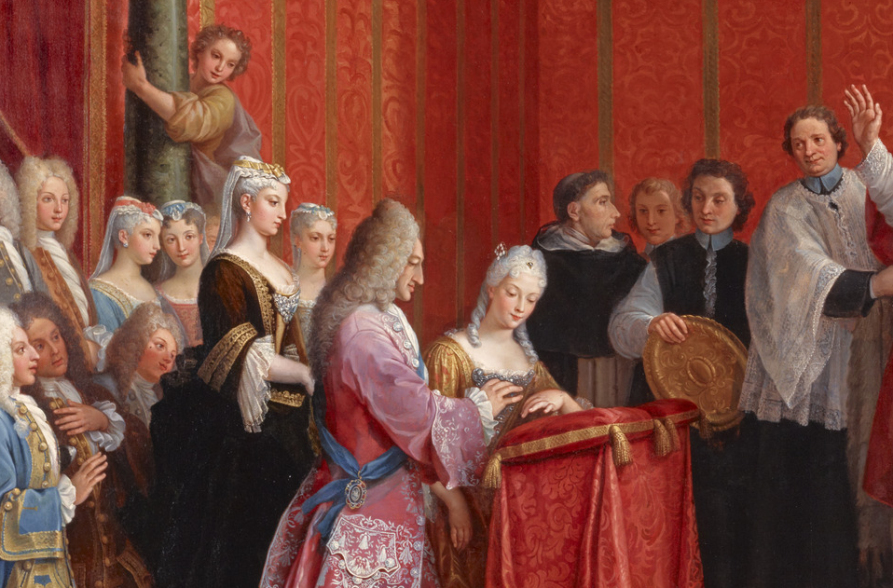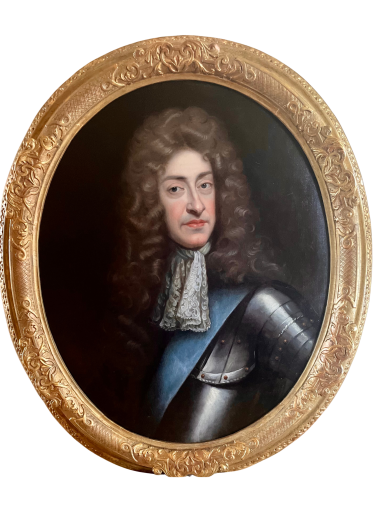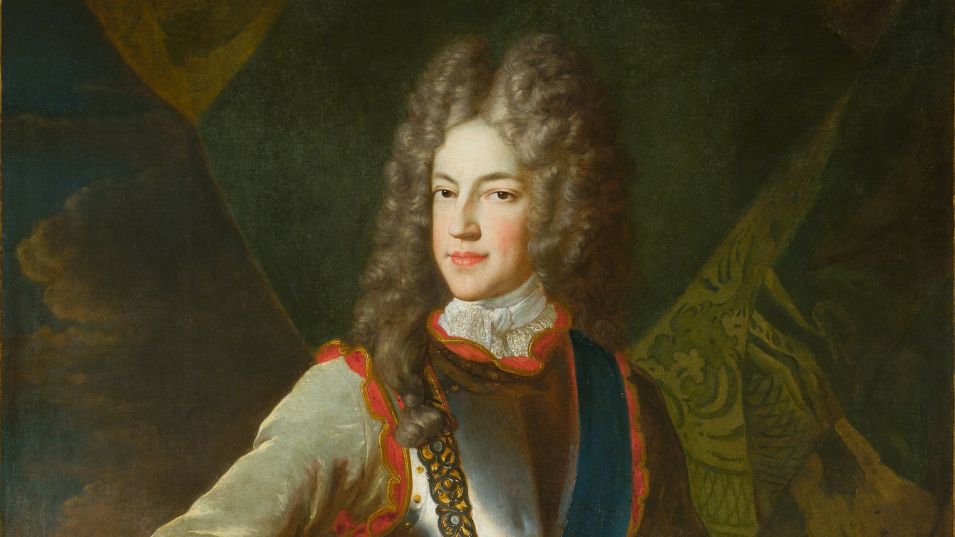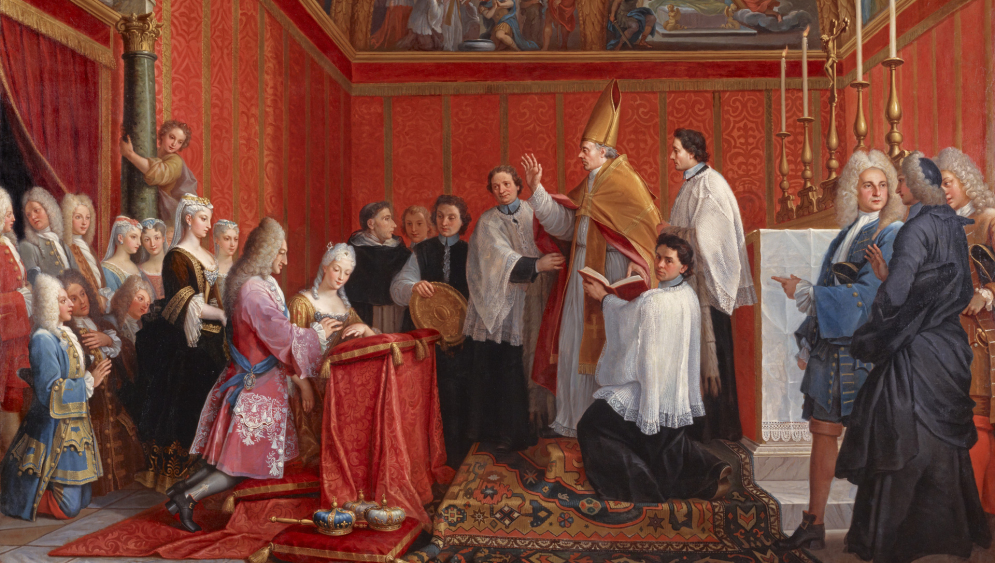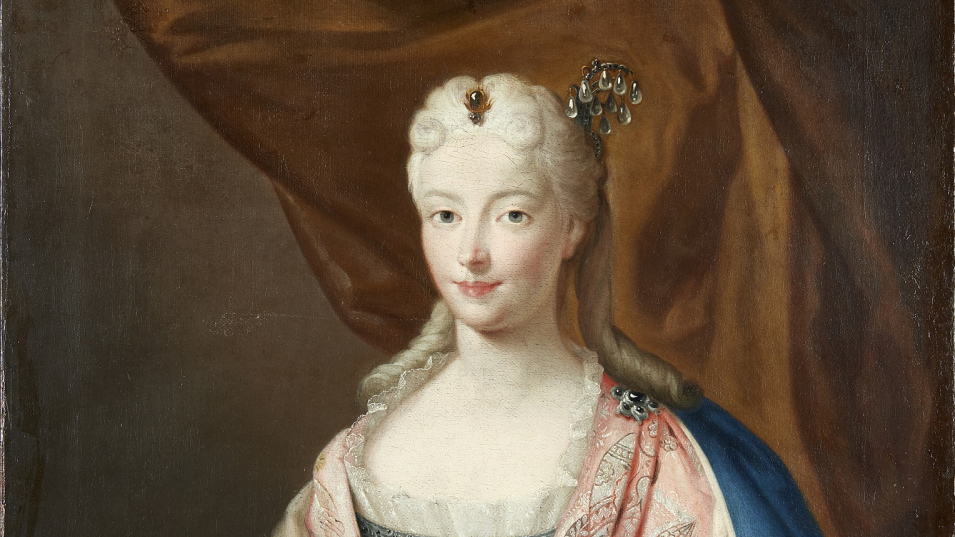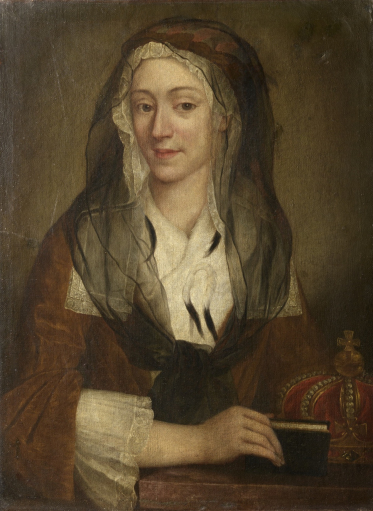The political situations of the Sobieski and Stuart royal families were very different, but nevertheless they were both living in exile. Unlike the three British thrones, the Polish throne was elective and Clementina’s father Prince Jakub Sobieski had failed to get himself elected to succeed his father in 1696. He had refused to pay homage to the new German King Augustus II, the Elector of Saxony, and had gone to live outside Poland in Silesia at Oława, a duchy acquired as part of his wife’s dowry, and which was in one of the hereditary Habsburg territories of the Holy Roman Emperor. In 1704 Prince Jakub had been arrested near Wrocław by the troops of Augustus II and imprisoned in Saxony. Augustus himself had then been deposed and replaced by Stanisław Leszczyński and forced in 1706 to release Prince Jakub who had signed a formal agreement never again to attempt to become King of Poland. Since then, Augustus II had been restored to the throne in 1709 and Prince Jakub had remained at Oława.
The thrones of England, Scotland and Ireland were hereditary but King James III/VIII’s father (James II/VII), who succeeded his brother Charles II in 1685, had been deposed in 1689 by his Dutch nephew William III of Orange. This was because of the way James had tried to give religious toleration and political equality to Roman Catholics and to those Protestants who did not conform to the established Church of England. James II/VII had gone to live in France at Saint-Germain-en-Laye near Paris. In 1696, following the death of Jan III, the King of France told James that the French ambassador in Poland had reported that some of the Polish-Lithuanian nobles hoped that he might put himself forward as a candidate for the vacant throne. James was very grateful but replied that he could not do that because it would imply that he was abdicating his British thrones. He therefore remained in France and died there in 1701. His son, born in London in 1688, succeeded him in exile as King James III/VIII and remained at Saint-Germain until 1712. Various attempts to achieve a restoration all failed and by 1717 he was living at Urbino in the Papal States in Italy. It seemed possible that King James might still be restored to his thrones, so Prince Jakub hoped that his daughter might soon be crowned Queen of England in London, the capital of the triple kingdom. That would strengthen his own political position in Poland. King James, who did not have a brother and whose sister had already died, was keen to marry a dynastically well-connected princess who would give him children to perpetuate the Stuart royal succession. It was expected that the marriage would be mutually beneficial to both families.
Before 1689 there had been no formal diplomatic contact between Jan III in Warsaw and the Stuart kings in London, although James II/VII’s brother-in-law Laurence Hyde had been sent to Poland on a special mission from 1676 to 1678. From 1689, however, and especially after Jan III’s death in 1696, the families almost certainly came into contact. In 1696 Prince Jakub’s two younger brothers, Aleksander and Konstanty, went to Paris and probably met James II/VII and his son at Versailles or Saint-Germain. Prince Jakub himself visited Paris in 1699 and probably also met them. Then Konstanty made a second visit in 1703. On each occasion the Sobieski brothers had their portraits painted by François de Troy, who between 1698 and 1703 was the official portrait painter to the Stuart royal family.
It was Jan III’s French widow Queen Marie Casimire who first suggested a Sobieski-Stuart marriage. She had left Poland and gone to live in Rome in 1699 where she remained until 1714. But in 1711 she made a visit to France and went to the Stuart court at Saint-Germain. When she was there, she suggested to the Dowager Queen Mary, the widow of James II/VII, a marriage between her eldest granddaughter (Maria Kazimiera) and Mary’s son James III. At that time the Stuarts were confident that they would soon be restored, and preferred to keep their options open to find a more important princess for James to marry. Rather than openly rejecting the offered marriage they put it off by asking for an impossibly large dowry. Several years later, in 1718, James III/VIII had still not been restored. He was still hoping for a restoration, but his position was now much weaker, especially as a rising in his favour in Scotland in 1715 had been defeated. A marriage to one of the Sobieski princesses, this time to the youngest, seemed a much more attractive proposition.
The marriage treaty between Prince Jakub Sobieski and King James III/VIII was signed at Oława on 22 July 1718. Clementina’s dowry consisted of 600,000 livres of rentes invested at the Hôtel de Ville in Paris, which had been inherited by Prince Jakub from his mother, and two other things, neither of which James ever actually obtained. They were the huge estate of Szawle (today Šiauliai) in northern Lithuania (near Courland and Livonia) and 250,000 livres owed by King Augustus II to Prince Jakub. The dowry also included some very valuable jewellery. In addition to the dowry Clementina brought to the Stuarts her family connections, notably with the Habsburgs of Austria (her maternal aunt Eleonora Magdalena was the mother of the Emperor Charles VI), the Wittelsbachs of Bavaria (her aunt Teresa Kunegunda Sobieska was the wife of the Elector Maximilian Emmanuel) and the Bourbons of Spain (her first cousin Elisabeth Farnese was married to King Philip V).
It was arranged that Clementina should travel with her mother from Oława to Italy and meet and marry King James at Ferrara in the Papal States. But King George I, the German Elector of Hanover and newly-chosen King of England, was keen to stop James getting married and having children, so he put pressure on the Emperor Charles VI to have Clementina and her mother arrested when they were travelling through Innsbruck. They were placed under house arrest in the castle of Ambras and the Emperor refused to release them. James responded by moving his court from Urbino to Rome, and then travelling to Spain where Clementina’s cousin Queen Elisabeth and King Philip V were preparing a fleet to invade England and depose George I.
During April 1719 two developments changed the situation and made possible the marriage of Clementina and James in Italy. The Spanish invasion fleet was destroyed by storms as it sailed up the Spanish Atlantic coast, so that any immediate hopes of achieving a restoration had to be abandoned. Meanwhile a small group of Irish military officers managed to help Princess Clementina (though not her mother) escape from Ambras and continue her journey south into Italy. There she was married to James by proxy in Bologna on 9 May. Now called Queen Clementina she then went on to live in Rome, waiting to meet her husband. James himself remained in Spain for a few months, but then had no option but to return to the Papal States. He met Clementina at Montefiascone (north of Rome) on 1 September and confirmed and formalized their marriage at midnight in the bishop’s private chapel opposite the cathedral. At the end of October, the newly married couple went to live permanently in Rome in a palazzo rented and furnished for them by the Pope. The royal families of Sobieski and Stuart were now united.
Prince Jakub Sobieski was disappointed because there never was a Stuart restoration during his lifetime, or later, so his daughter, who predeceased him, never was crowned queen in London. By the time he died in 1737, however, Clementina had given birth to two boys, Prince Charles in 1720 and Prince Henry in 1725. In that sense the marriage was the dynastic success that King James hoped for. But otherwise, the marriage was a failure.
It seemed to get off to a good start, and King James wrote to Prince Jakub in October 1719 that ‘the more I know her, the more I am happy she is mine’[1]. But James did not treat Clementina with the respect that she felt she merited. Perhaps because she was very young, but more likely because he wanted to have complete control over all the servants at his court in the Palazzo del Re, James refused to let Clementina have her own separate household, staffed by servants appointed and controlled by her. Moreover, he showed great favouritism towards three Scottish Protestants at his court who were disrespectful to her. These were John Hay, his wife Marjory, and the latter’s brother James Murray. King James allowed these three Protestants to dominate the court and Clementina strongly disliked them. Her position was made more uncomfortable because James was especially friendly with Marjory Hay who was approximately his own age and could speak to him in English which Clementina did not yet understand. As John Hay once wrote to Clementina, ‘even before your Majesty had been six weeks married’ you became jealous ‘as to the King’s conduct in relation to Mrs Hay’[2]. To make matters worse the king appointed Marjory Hay to be Clementina’s only lady of the bedchamber with responsibility for attending her within the palazzo and accompanying her when she went out.
Murray was so unpopular both at the court and in England and Scotland that the king felt obliged to ask him to leave. That was at the beginning of 1721, shortly after Clementina gave birth to Prince Charles. But John and Marjory Hay remained, and Clementina wrote to Prince Jakub that she felt neglected and scorned. The favourites, she wrote, monopolized her husband’s attention and treated her ‘with a haughtiness as though I were the lowest of creatures’[3].
Matters came to a head in September 1722 when John Hay, now Earl of Inverness (in the Jacobite peerage of the exiled Stuarts), sent Clementina an impertinent and insulting letter. In it he informed the queen that she was wrong to think that his wife Marjory was having an affair with her husband the king. He then asked Clementina not to tell anyone, and especially not her husband, that he had written this letter to her, and even asked Clementina to return it to him. She was so angry that she showed the letter to her husband and demanded that John and Marjory Hay (Lord and Lady Inverness) should be ordered to leave the court. King James refused to send them away, so Clementina stopped speaking to him or even looking at him. As a result, as James himself put it, ‘I suffer’d your pouting humours … and you would scarce speak to me, or look upon me’[4]. James admitted to Prince Jakub that Clementina was unhappy, but he did not tell him why.
Despite this Queen Clementina became pregnant again in the summer of 1724 and gave birth to Prince Henry in March 1725. It was this that finally brought about a crisis at the Stuart court.
It was normal at the English court for princes to be looked after by women until they reached the age of seven, when they would be handed over to be looked after by a team of men. That is what happened to James himself when he was young. But in the summer of 1725 James decided that Prince Charles, who was then still only four years old, should be taken away from the care of the women who were looking after him and entrusted to a group of men. The men were all Catholics but they were to be subordinate to the prince’s new governor, who would be Protestant. The new governor was James Murray, (now Earl of Dunbar in the Jacobite peerage), whom Clementina detested and whom the king recalled to his court to take up the appointment. Moreover, the king ordered that Clementina should no longer be allowed to see her four-year-old son Charles unless Dunbar was also present. This was too much for Clementina, so she threatened to leave the court and take refuge in a convent if her husband did not both order Lord and Lady Inverness to leave the court and dismiss Lord Dunbar from his position as governor of Prince Charles. The king refused to do either of these and told her that she should not take ‘so important a resolution, without communicating it to the Prince your Father, for I am persuaded he would have used his utmost endeavours to calm you, and hinder you’[5]. Because her husband would not do what she asked, Queen Clementina did leave the court and went to live in the convent of Santa Cecilia in Trastevere (the other side of the river Tiber).
A few days later Clementina wrote to inform her father that she had left the court and to explain her reasons for doing so. Prince Jakub Sobieski replied that she should return to her husband as soon as possible. He explained to her that, both as a king and a husband, James had every right to make decisions and that it was her role to obey him and to accept that he might employ people whom she did not like. In a series of letters to her father she explained how uncomfortable her position had become and why she had eventually felt obliged to leave the court. After all, she wrote, she was of the Sobieski family, she was Prince Jakub’s daughter and King Jan’s granddaughter, and related to many European rulers. She added that the Pope, most of the cardinals in Rome, and the King and Queen of Spain supported her. So, Clementina remained in the convent, where of course she could not see her two sons, and resisted the attempts of her husband and father to make her return to the Palazzo del Re.
Clementina remained in the convent from November 1725 until July 1727. During that time King James decided to leave Rome and move his court to Bologna where he rented two adjacent palazzi. A compromise was eventually reached because the Pope wanted James and Clementina to be reconciled and Clementina felt she had to give way. James agreed that she should have her own independent household, but he appointed the people to serve in it. Lord and Lady Inverness left the court, but Lord Dunbar remained the governor of Prince Charles and became the governor of Prince Henry as well when he was four years old. This compromise favoured her husband but it enabled Clementina to leave the convent and rejoin the court in Bologna. In 1729 the Stuart royal family then returned to Rome. The king and queen now lived separate lives and Clementina occupied herself with charitable works and her religious devotions.
One example of this is that she joined the Archconfraternity of the Most Holy Name of Mary (Santissima Nome di Maria) in about 1731. It had been founded in 1685 to celebrate her grandfather Jan III’s victory at Vienna, and it had a church to which she went quite near the Palazzo del Re in Trajan’s Forum.
In 1733 King Augustus II died and the Polish throne was once again disputed. Prince Jakub Sobieski wrote to Clementina that he would ‘do all in his power to place the Crown of Poland’ on her husband’s head. He explained that ‘many nobles of Poland’ had ‘declared their support for him (namely Jakub Sobieski), but that he would give King James ‘that interest, and those suffrages which he had for his own election’. James wrote back to his father-in-law that he did not think he would be elected but that even if he were he would not be able to accept the offer. His letter is worth quoting at some length because of the light that it sheds on the relations between the Sobieski and Stuart families:
‘… were the crown even to be offered me, I must frankly own to you, that I am not at liberty to accept it. Providence has destined me for another, and it is this other only that has a right to all my cares and thoughts. I consider myself as under an indispensable obligation of … labouring for my Restoration…. I must own to you, that my own country engages my whole heart, and all my inclinations…. A nation so brave, and so renowned as that of Poland deserves such a king, as can devote all his cares and inclinations to it…. It cannot therefore be convenient for Poland to have me for its king…. I own I shall heartily regret that my son Henry the Duke of York is not of an age to be a candidate: the blood of the Sobieskis runs in his veins’[6].
As both King James and Prince Jakub were very conscious, the two Stuart princes were half-Polish as well as half-British.
At the end of 1734, by which time Augustus III had achieved victory in the War of the Polish Succession, Prince Jakub Sobieski left Oława in Silesia and returned to live at his family’s seat at Żółkiew, north of Lwow. The exile of the Sobieski family from Poland therefore came to an end. A few months later, in January 1735, his daughter Clementina died in Rome. Prince Jakub therefore began to correspond with his eldest Stuart grandson Prince Charles, and developed plans to have both of his grandsons’ ‘princely status formally incorporated within Poland’. As Peter Pininski has explained:
‘This parliamentary process, known as the indygenat, related to the recognition and acceptance of foreign nobles into the ranks of the Polish-Lithuanian nobility, giving them all the rights of that class. Sobieski saw his grandsons’ future in Poland as heirs to his massive estates…. But the indygenat was essential if Charles and Henry were to inherit, because only those who belonged to the Polish-Lithuanian nobility could own land in that country’[7].
In March 1735 Prince Jakub tried to obtain the support of the Tsarina Anne of Russia, who had supported Augustus III, that Clementina’s sons ‘might receive the indygenat at the next session of the Polish parliament’[8], but the matter had still not been resolved when he died in December 1737. This meant that he had to leave his estates in Poland to Clementina’s elder sister Maria Karolina, Duchess of Bouillon, and only his rights to the estates at Oława in Silesia to his grandsons. He also bequeathed to them the Polish crown jewels which had been entrusted to the Sobieski family as security for a large loan, and which were now deposited as security for any future loans to the Stuarts at the Monte di Pietà in Rome.
With the deaths of Queen Clementina and Prince Jakub the relations between the Sobieski and the Stuart royal families effectively came to an end. But this is no way made the Stuarts less conscious of their Polish inheritance. After Maria Karolina sold the Sobieski estate of Żółkiew to her second cousin Prince Michał Radziwill (grandson of Jan III’s sister) Prince Charles hoped for a while that his brother Henry might marry one of Prince Michał’s daughters. And for many years King James and Prince Charles negotiated how best to obtain their inheritance at Oława, made more complicated by the conquest and annexation of Silesia by Frederick II of Prussia.
The Sobieski and Stuart royal families were brought together in a dynastic marriage which lasted from 1719 to 1735, and which was caused by the exile of each family from Poland and England. Although James and Clementina had two sons, neither family was destined to recover the throne which it had possessed. Neither was even destined to survive. Prince Jakub Sobieski did not have a son. He had two brothers, but both died before him, leaving no legitimate children. Prince Charles Stuart had no legitimate children and died in 1788. He did have an illegitimate daughter, Charlotte Stuart, whom he formally legitimized and made his heir in 1783, but she died a year after him. Prince Henry Stuart became a cardinal of the Roman Catholic Church and also had no children. When he died in 1807 the Sobieski and Stuart families both finally became extinct, and by then Poland had even ceased to be an independent kingdom. But for a period of about fifteen years the two royal families had been brought together in a dynastic alliance. The present exhibition reminds us of this important Polish-British moment in European history and, among other things, includes portraits of the members of both families painted by some of the most talented artists of the late seventeenth and early eighteenth centuries.
Edward Corp was Professor of British History at the University of Toulouse. He has written a history of the Stuart Court in exile in France and Italy, 1689–1766, in three volumes (published by Cambridge University Press and Palgrave Macmillan), a biography of Sir David Nairne (Peter Lang) and about eighty articles in books and peer reviewed journals. These articles include many on the history of baroque music in France and Italy, and on 17th and 18th century French and Italian portraits. He has curated two major exhibitions on the exiled Stuarts, in the Château-Vieux de Saint-Germain and at the Scottish National Portrait Gallery. His book The Jacobites at Urbino was translated into Italian (Il Mulino, Bologna). He has edited four collections of essays on Jacobitism. He has also published a biography of Sir Eyre Crowe, 1864–1925, and several articles on the early 20th century Foreign Office.
Footnotes
[1] Aleksandra Skrzypietz, ‘Marital Crisis between Maria Clementina née Sobieska and James Stuart in the Light of her Correspondence with her father’, in I Sobieski a Roma: La famiglia reale polacca nella Città Eterna, eds. Juliusz A. Chrościcki, Zuzanna Flisowska and Paweł Migasiewicz (Warszawa, Muzeum Pałacu Króla w Wilanowie, 2018), p.363, James III to Jakub Sobieski, 13 October 1719.
[2] Edward Corp, The Stuarts in Italy, 1719-1766: A Royal Court in Permanent Exile (Cambridge University Press, 2011), p.147, Hay to Clementina, September 1722.
[3] Edward Corp, ‘Clementina Sobieska at the Jacobite Court’, in The Irish to the Rescue: The Tercentenary of the Polish Princess Clementina’s Escape, ed. Richard K. Maher (Peter Lang, Oxford and Berne, 2021), pp.121-43, at p.131, Clementina to Jakub Sobieski, 19 January 1726.
[4] Windsor Castle, Stuart Papers 87/64, James III/VIII to Clementina, 11 November 1725.
[5] Ibidem.
[6] Cardiff, National Library of Wales, Powis Papers 22/28, James III/VIII to Jakub Sobieski, 28 March 1733.
[7] Peter Pininski, Bonnie Prince Charlie: His Life, Family, Legend (Edinburgh, National Museums of Scotland, 2022), p.35.
[8] Ibidem.
General books about the Sobieskis and the Stuarts in exile
- Edward Corp, A Court in Exile: The Stuarts in France, 1689–1718 (Cambridge University Press, 2004)
- Edward Corp, The Jacobites at Urbino: An Exiled Court in Transition (Basingstoke, Palgrave Macmillan, 2009)
- Edward Corp, The Stuarts in Italy, 1719–1766: A Royal Court in Permanent Exile (Cambridge University Press, 2011)
- Peter Pininski, Bonnie Prince Charlie – His Life, Family, Legend (Edinburgh, National Museums of Scotland, 2022)
- Aleksandra Skrzypietz, Królewscy synowie – Jakub, Aleksander I Konstanty Sobiescy (Katowice, Wydawnictwo Uniwersytetu Śląskiego, 2011)
- Aleksandra Skrzypietz, Maria Klementyna Sobieska, królowa i Służebnica (Katowice, Wydawnictwo Uniwersytetu Śląskiego, 2022)
Manuscript sources
- Queen Clementina’s correspondence with Prince Jakub Sobieski during the Sobieski-Stuart marital crisis of 1725-26 is at:
Belarus, Nacyjanalnyi Gistaeycznyi Archiu Bielarasu w Minsku, f.694, o.12, rkps 358-60, quoted at length in Aleksandra Skrzpietz, ‘Marital Crisis between Maria Clementina née Sobieska and James Stuart in the Light of her Correspondence with her father’, in I Sobieski a Roma: La famiglia reale polacca nella Città Eterna, eds. Juliusz A. Chrościcki, Zuzanna Flisowska and Paweł Migasiewicz (Warszawa, Muzeum Pałacu Króla w Wilanowie, 2018). - King James III’s correspondence with Queen Clementina and Prince Jakub Sobieski during the crisis is at:
United Kingdom, Royal Archives at Windsor Castle, Stuart Papers, Main volumes 87 and 90.
